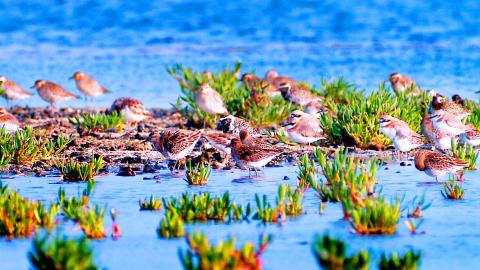The Ministry of Science and Technology is to boost scientific facilities on the Pratas Islands (Dongsha Islands, 東沙群島) and Itu Aba Island (Taiping Island, 太平島), and increase collaborations with Southeast Asian countries, a ministry official said yesterday.
Minister of Science and Technology Chen Liang-gee (陳良基) on Friday led a delegation of 64 government officials and researchers to inspect facilities on Pratas, and meet with US and Japanese scientists.
The inspection is part of the ministry’s four-year Integrated Program for Intelligent Prevention of Natural Disasters and International Cooperative Research on Earth Sciences in Southeast Asia, which began last month and runs through 2022, Department of Natural Sciences and Sustainable Development Director-General Wu Chun-chieh (吳俊傑) said.

Photo: Copy by Tsai Ching-hua, Taipei Times
The program — composed of four subsidiary projects — aims to boost the nation’s atmospheric, maritime, Earth science and disaster prevention research efforts on and around the islands, and to share technologies with countries included in the government’s New Southbound Policy, Wu said.
First, the ministry plans to enhance research equipment at the scientific research station on Pratas, as well as improve its maintenance and support systems, with National Sun Yat-sen University professor of oceanography Soong Ker-yea (宋克義) serving as project head, Wu said.
Humanities researchers were part of the inspection, with an eye to inspiring new research based on the island’s extraordinary social and cultural conditions, he said.
On Itu Aba, the ministry is seeking to advance atmospheric observations by upgrading surface-based observation infrastructure, installing new cloud observation facilities and launching more climate data-gathering equipment, with National Taiwan University Department of Atmospheric Science chair Lin Po-Hsiung (林博雄) leading the project, Wu said.
The third project is to share the nation’s disaster prevention and early-warning systems for earthquakes with Southeast Asian countries, given that “Taiwan is a leader in disaster prevention studies in the region,” Wu said, adding that the project would be managed by National Science and Technology Center for Disaster Reduction Director Hongey Chen (陳宏宇).
Through the fourth project, the ministry plans to fortify connections between Taiwanese and Southeast Asian academics, and foster student and expert exchanges, with Academia Sinica Institute of Earth Sciences director Chung Sun-lin (鍾孫霖) leading the project, Wu said.
Hopefully, the projects would enlarge the nation’s presence on the global stage and lead to more bilateral and multilateral collaborations, Wu said, adding that the ministry is focused on scientific research and collaborations, not political issues.
The ministry is to share research findings with scientists working for Year of the Maritime Continent, a two-year project that began last year to study the climate of the Earth’s largest archipelago, which stretches from the Indian Ocean to the Pacific Ocean, Wu said, adding that Taiwan contributes by sharing observations collected on Itu Aba and Pratas.

TRAGEDY STRIKES TAIPEI: The suspect died after falling off a building after he threw smoke grenades into Taipei Main Station and went on a killing spree in Zhongshan A 27-year-old suspect allegedly threw smoke grenades in Taipei Main Station and then proceeded to Zhongshan MRT Station in a random killing spree that resulted in the death of the suspect and two other civilians, and seven injured, including one in critical condition, as of press time last night. The suspect, identified as a man surnamed Chang Wen (張文), allegedly began the attack at Taipei Main Station, the Taipei Fire Department said, adding that it received a report at 5:24pm that smoke grenades had been thrown in the station. One man in his 50s was rushed to hospital after a cardiac arrest

SAFETY FIRST: Double the number of police were deployed at the Taipei Marathon, while other cities released plans to bolster public event safety Authorities across Taiwan have stepped up security measures ahead of Christmas and New Year events, following a knife and smoke bomb attack in Taipei on Friday that left four people dead and 11 injured. In a bid to prevent potential copycat incidents, police deployments have been expanded for large gatherings, transport hubs, and other crowded public spaces, according to official statements from police and city authorities. Taipei Mayor Chiang Wan-an (蔣萬安) said the city has “comprehensively raised security readiness” in crowded areas, increased police deployments with armed officers, and intensified patrols during weekends and nighttime hours. For large-scale events, security checkpoints and explosives

A car bomb killed a senior Russian general in southern Moscow yesterday morning, the latest high-profile army figure to be blown up in a blast that came just hours after Russian and Ukrainian delegates held separate talks in Miami on a plan to end the war. Kyiv has not commented on the incident, but Russian investigators said they were probing whether the blast was “linked” to “Ukrainian special forces.” The attack was similar to other assassinations of generals and pro-war figures that have either been claimed, or are widely believed to have been orchestrated, by Ukraine. Russian Lieutenant General Fanil Sarvarov, 56, head

PUBLIC SAFETY: The premier said that security would be tightened in transport hubs, while President Lai commended the public for their bravery The government is to deploy more police, including rapid response units, in crowded public areas to ensure a swift response to any threats, President William Lai (賴清德) said yesterday after a knife attack killed three people and injured 11 in Taipei the previous day. Lai made the remarks following a briefing by the National Police Agency on the progress of the investigation, saying that the attack underscored the importance of cooperation in public security between the central and local governments. The attack unfolded in the early evening on Friday around Taipei Main Station’s M7 exit and later near the Taipei MRT’s Zhongshan